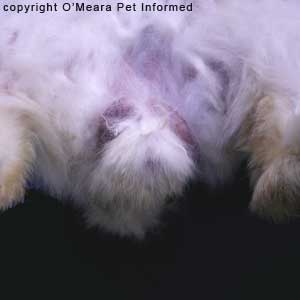
The colliculus seminalis a valvelike structure at the entry of VG from the urethra controls the release of sperm and VG secretion in rabbits. The scrotal sacs sit craniolateral to.

Each digit has an associated toenail.
Male rabbit anatomy. Rabbit anatomy male It is so interesting to know the unique features of male and female organs from the rabbit anatomy. Lets start with the anatomical features of the male organs of rabbits. First you might know the different organs of the male organ system of a rabbit.
You will find the same organs in this system as you found in other animals. The sexes are separate and sexual dimorphism is well marked in rabbit. Male reproductive system Fig.
2970 consists of a pair of testes a pair of vasa deferentia uterus mascuiinus or seminal vesicle urethra penis and a number of accessory glands like prostate Cowpers perineal and rectal glands. The head and body of the intact adult male rabbit is generally more thickset than the doe Richardson 2000. The penile sheath is cylindrical and the penis can be easily extruded in rabbits over 2 months of age.
The scrotal sacs sit craniolateral to. It is the main source of testosterone in rabbits 19 which is the main androgen produced during sexual maturation 20. They are positioned cranially to the penis 13 16 located in the scrotum each one on one side of the inguinal line and positioned almost horizontally 17.
Rabbits have 7 tarsal bones the ankle and 4 digits on both hind legs and 9 carpal bones the wrist and 5 digits on both fore legs. Each digit has an associated toenail. Weakened bones and bones affected by osteoporosis are easily injured or broken.
Various types of spinal deformations have been observed in a rabbits anatomy. Spraying is when rabbits mark their territory with their pee. They will usually but not always spray onto a vertical surface and it will usually be in little spurts at a time.
This is especially common in male rabbits but female rabbits are also known to partake in spraying behaviors. Spraying is almost always solved by getting your rabbit. The morphology and microscopic anatomy of the reproductive organs and colliculus seminalis of the male rabbit are described and illustrated.
The rabbit shows a typical mammalian form of the body which consists of head neck trunk and tail. The trunk is further divisible into thorax and abdomen. The head is large and spherical posteriorly but produced anteriorly into a large pointed blunt snout or muzzle.
The head bears the following structures. Breed of the rabbit does not really say anything about their personality whatsoever so knowing the breed will not make more or less certain what an unneutered male rabbit will act like. Breed generalizations like the gentle giants for Flemish Giants or the Napoleon Complex of Netherland Dwarves I think are just the Barnum effect at this point.
However the anatomy of wild rabbits and domesticated rabbits is identical. Male rabbits are identified as bucks whereas female rabbits are called does. A doe pro-duces a litter which is a group of young rabbits all born at the same time.
The anatomy of a rabbit is similar to that of many other species. A rabbit has ears a nose a tail and feet. In rabbit the sexes are separate ie.
Unisexual and sexual dimorphism is well marked. The male reproductive organs include a pair of testes a pair of epididymes a pair of vasa deferentia urethra penis and some accessory glands. The paired testes are small ovoid bodies of light pink colour.
The male reproductive system in rabbit consists of pair testis epididymis ampoules vas deferens urethra penis glands and accessory glans 10 but the sensitive organ in the male. RABBIT The urogenital anatomy of male rabbits presents a peculiarity unique among placental mammal species but common in marsupial species. The penis is located caudal to the testicles which lie cranial to the penis in two separate hemiscrotal sacs.
Unlike most other animals male rabbits have a scrotal sac for each testicle and they are not behind the penis but at each side and slightly forwards nearer the belly. Male rabbits possess a life-long ability to move freely their testis between the scrotum and the abdomen via the inguinal ring. The response occurs during handling and examination or during a fight between 2 males.
Indeed entire male rabbits will inevitably fight and attempt to neuter the other male by biting in the scrotal region. The morphology and microscopic anatomy of the reproductive organs and colliculus seminalis of the male rabbit are described and illustrated. Here in this male rabbit.
Females have those glands too less numerous. The age at which sexual maturity is reached depends on the size and the breed. While small and middle sized rabbits become adult between 4 and 6 months it may take between 5 to 8 months for giant breeds.
A male rabbit is called a buck and tends to be more easy-going and laidback compared to a female rabbit. Once you neuter your rabbit he will be less destructive and neutering is not as expensive as spaying. Physically the only way to tell if you have a male rabbit is by his two oblong testicles which dont descend until he.
To carry a rabbit it is useful to support the animals body between the forearm and abdomen of the handler with the rabbits face hidden under the handlers elbow. Frightened or so-called nervous rabbits are usually easily carried by this method. Anatomy and Physiology.
2 - 6 kg female. 2 - 5 kg male. The unique anatomy of the urogenital tract in male rabbits as well as the anesthesia technique used during catheterization may play a role in misplacement of catheters into the VG.
The colliculus seminalis a valvelike structure at the entry of VG from the urethra controls the release of sperm and VG secretion in rabbits.